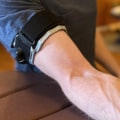BFR training, like any other form of exercise, contains some elements of risk and health complications. A lot of worries come to mind when you think about restricting blood flow. There are few real risks that accompany occlusion training, as long as it is done safely with help. Most studies show that occlusion training is as risky as traditional exercise.
BFR training bands are only one or two inches wide, so they put pressure on a small area of the muscle. Its use is risky, there is simply too much room for error. Very little pressure and not worth much. If it's too tight, it can damage your nerves.
Current research suggests that occlusion training, or BFR, may be a safe and effective way to increase muscle strength and size. To improve muscle strength and hypertrophy, the American College of Sports Medicine recommends resistance training at moderate to high loads. However, the use of moderate to high loads is often not feasible in clinical populations. Therefore, the emergence of low-load (LL) blood flow restriction (BFR) training as a rehabilitation tool for clinical populations is becoming popular.
Although most research on LL-BFR training has examined healthy populations, clinical applications are emerging. In general, it seems that bfr training is a safe and effective tool for rehabilitation. However, additional research is needed before widespread application. You want to limit the restriction to 50 percent of the limb occlusion pressure for the upper body and 80 percent of the pressure for the lower body, says Becourtney.
Full body biohacking workouts are too crazy for me, so I like to limit training to the lower body. I'm pretty convinced of the potential benefits, but since you're restricting blood flow, you obviously want to be smart about trying it yourself. This process sends a variety of muscle development signals to the body, and all this happens with a lighter weight load than is necessary with standard strength training. Frequent blood flow restricts training not to failure and to failure induces similar gains in myonuclei and muscle mass.
Despite this growth, aspects such as understanding appropriate pressure application patterns, the variety of BFR technologies, safe implementation in practice, and the importance of perceived effort in training to foster long-term compliance can be barriers to successful integration into the plan. care. Increased FXYD1 and PGC-1α mRNA after running with blood flow restriction is related to fiber-type specific AMPK signaling and oxidative stress in human muscle. Rehabilitation environments favor BFR training for a combination of reasons, but most of its popularity seems to be due to low-load training using rapid improvements with no risk to the surgical site.
According to multiple research studies, wider cuffs lower the pressure needed to restrict blood flow. The underrepresentation of women could be influenced by the menstrual cycle or the use of oral contraceptives that could confuse blood hemostasis analysis. Aspects such as cuff width, pressure and material are taken into account when starting occlusion training. According to the review mentioned above, some studies have reported patients experiencing adverse effects after training with BFR.
BFR training promises that you can do relatively easy workouts and get the same results as if you were to crush a hard workout in the gym. .



Leave Reply